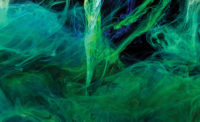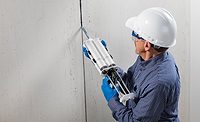Repackaging Options for Two-Component Adhesives, Sealants and Coatings
Many factors determine the size and format of the optimal adhesive, sealant or coating package.
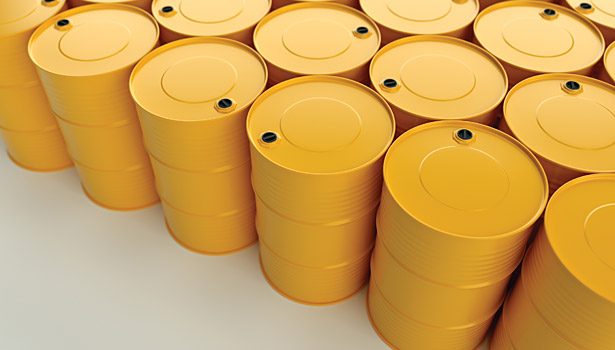
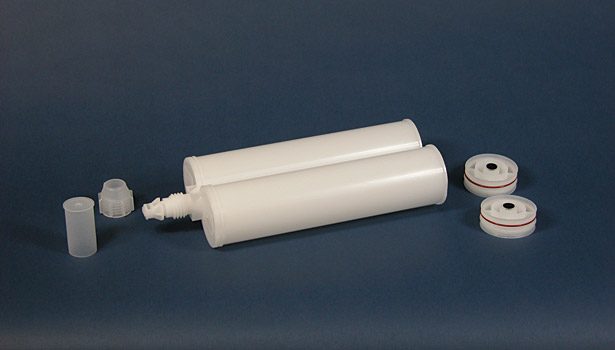
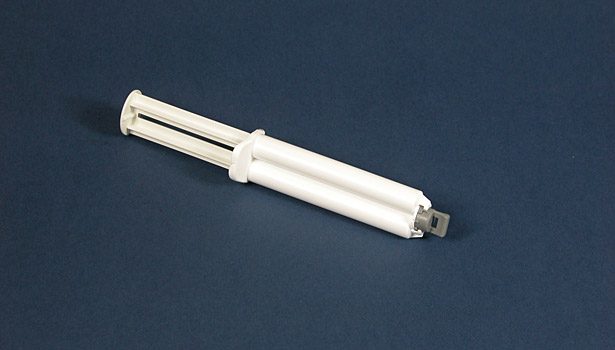
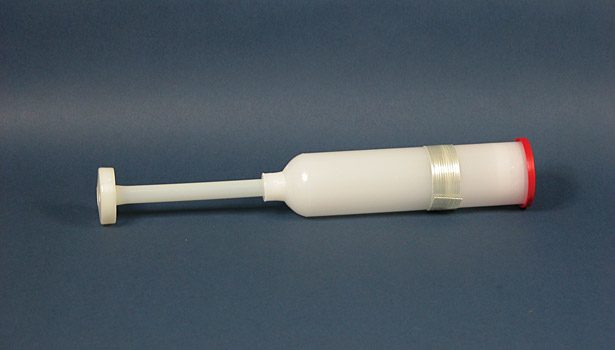
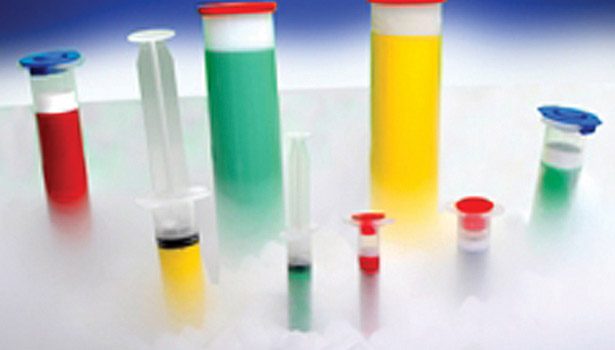







More and improved packaging options are available today for two-part chemistries than ever before, including side-by-side cartridges for extrusion or spray, dual syringes, syringe kits, jar kits, twin pouches (both burst and clipped), barrier kits, injection kits, and premixed and frozen syringes/cartridges. The demand for packing down from totes, drums and pails into smaller units such as gallons, quarts and pint kits also still exists. If material modification is required, such as color change, viscosity change, or the addition of conductive fillers or spacer beads, it is an advantage to have this accomplished as part of the repack process.
Side-by-Side Cartridges
One of the most popular package types, side-by-side cartridges equate to a mini-meter/mix system without the capital expenditure and maintenance associated with meter mix/dispense equipment (MM/D). The same style of disposable mixer nozzle used with MM/D equipment is also used with dual cartridges.
The most common extrusion-style cartridge sizes include 50, 75, 100, 150, 200, 300, 375, 400, 450, 600, 900 and 1,500 ml (others are available that are less common). Formula mix ratio requirements dictate the actual size options applicable for repack. The more common compatible volumetric mix ratios include 1:1, 2:1; 3:1, 4:1 and 10:1. A 3:2 mix ratio is also available in the 50-ml cartridge.
Both pneumatic and manual applicators are used to dispense material. Pneumatic is the best choice if it is practical at the point of use. It assures a homogenous blend when dispensing out of the mixer nozzle.
A newer growth area for side-by-side cartridges is spray coatings. To be able to apply coatings in remote areas is a great way to make repairs or perform on-site applications without the need for cumbersome spray equipment. The only requirement is that an air source is available for the applicator. Cartridges sizes are similar to those listed previously, but larger size cartridges are more practical. Popular standard sizes include 1,500 (1:1 ratio), 1,125 (2:1 ratio), 1,000 (3:1 ratio) and 940 ml (4:1 ratio). These cartridges can accommodate a variety of viscosities. For fine tuning, one or both sides may be thinned out or thickened to make sure that the two parts blend and coat effectively. If material modification is required, it is a bonus if the repackager has the ability to perform these services prior to repacking the coating into the cartridges.
The limitations of side-by-side cartridges are that they only accommodate certain mix ratios, and they are not recommended for formulas that have fillers that settle quickly (although cold-temperature storage, periodic rotation of inventoried cartridges and shaking prior to use can offset the settling issue in some cases). For a compatible formula, these cartridges are among the most efficient delivery systems. There is minimal waste and no air is introduced by the mixer nozzle during dispensing. The entire mass of material does not have to be used, as in other systems. It is possible to use these cartridges for multiple applications over time, with only the disposable mixer nozzle needing to be replaced when it is time to continue use.
Dual Syringes
Dual syringes are similar to side-by-side cartridges, but they hold a smaller quantity of material and a manual plunger is used to dispense the material (vs. a manual or pneumatic applicator). There are fewer options for volumetric mix ratios as well (e.g., 1:1, 2:1, 4:1 and 10:1). Sizes range from 2.5 to 30 ml total capacity; popular sizes include 4, 10 and 30 ml.
Static mixer nozzles are an option with some (but not all) dual syringes. Manual plunger dispensing through a mixer is not always practical, especially with thicker materials in a larger syringe. However, many applications do use mixer nozzles. Test samples can help to determine the viability of the package. Dual syringes are often used for repair, touchup jobs and in-field kits.
Barrier and Injection Kits
Available sizes of barrier and injection kits include 2.5, 6 and 8 oz, as well as 1/10th gal (standard caulking cartridge dimensions) and 20 oz. The barrier kit has an internal foil partition that keeps the resin and catalyst separated. Mixing is accomplished by removing the external tape at the foil partition and stroking clockwise with a mixer rod/internal propeller for 60-80 strokes. This can be done manually or with auto-mixers.
The injection kit has the catalyst in the mixing rod, so no barrier is necessary. The mix ratio determines the style of kit to be used; 1:1 up to 10:1 ratios call for the barrier style, while 10:1 and greater call for the injection style. If the application is borderline, the injection kit is the better choice because it is easier to use. To blend material, a ram rod is used to move the catalyst into the cartridge, and the mixing process is the same as the barrier kit. Dispensing is accomplished with a manual or pneumatic applicator.
The benefits of barrier and injection kits are that there are no mix ratio restrictions (as there are with side-by-side cartridges), and the mixing process redistributes filler that may have settled in the cartridge. A drawback to these kits is that a small amount of air may remain in the material. Also, because the entire content of the cartridge is mixed, it must be used within the working life (pot life) of the material. While barrier and injection kits were initially used for aerospace and airframe applications, many different industries also now use them.
Two-Component Pouches
Made of a laminate film or foil for solvent- or moisture-sensitive materials, two-component pouches can be used for almost any mix ratio. Pouches come in two styles: burstable and clipped. The burstable style, which is the most widely used, has a burst seal dividing it at a location that creates the target mix ratio. Parts A and B are packed into the respective sides, and heat sealing creates the closure of the pouch. One end of the pouch is rolled up until the burst breaks, forcing the material into the other side, essentially creating a pouch with one cavity. The pouch should be repeatedly run over the edge of a table or workbench until parts A and B are completely blended. To dispense blended material, a corner is snipped off and the material is squeezed out.
A new generation of burst pouches includes a spout with a needle adapter option. This pouch has a second burst located just below the spout. With this style pouch, no snipping is required. The blended material is used to break the second burst, and it is then dispensed out of the spout or needle.
In a clipped pouch, the pouch is folded over a rod at the desired location, and a clip is put in place to secure the barrier. The two sides are filled and sealed, and the clip and rod are removed to create a one-cavity pouch. The remaining steps are the same as for the burstable pouch.
Two-component pouches are ideal for field kits, touchup work or other small jobs. Larger pouches are used for applications at outdoor installation jobsites. No applicators are needed to use this package format. Not all materials work well in this format, however. As with all repackaging, it is best to obtain samples in order to perform a full evaluation.
Premixed and Frozen Syringes
Premixed and frozen (PMF) is a practical packaging solution when the end user requires perfectly blended and air-free material applied to the target part with no in-house processing. In PMF packaging solutions, both the blending and container are built-in benefits. PMF is an excellent packaging option for small, repeatable dot applications by performed by automated dispensing/robotics. It is also often used with basic pneumatic tabletop dispensers. It is also a very good option for expensive materials, such as silver-filled epoxies. When properly used, PMF eliminates all but the smallest amount of waste.
The PMF process consists of blending batches of two-part material, vacuum degassing and filling into syringes. Centrifuging of the syringes may be used to remove air entrapment that can occur during syringe packaging. The syringes are then placed in a dry ice bath to flash-freeze, which stops the curing process. Syringes are shipped on dry ice via overnight delivery service to ensure they remain frozen during transit. Upon arrival, the syringes must be unpacked from dry ice and placed into a -40F freezer. The most common size freezer is 5 cu ft and costs roughly $3,000. Packaging costs are sensitive to the pot life/working life of the formula involved. Quick-curing materials require small batch blending to ensure a minimal amount of time passes before the syringes are packed and brought down to frozen temperature.
PMF is not practical for very fast-setting formulas. Conversely, packaging costs go down with longer work life formulas because the batch sizes can be larger. This type of package requires the initial expense for a freezer, as well as additional freight costs related to overnight delivery service. For some applications, however, the PMF packaging solution’s benefits and quality assurance often outweigh those costs.
For additional information, contact the author at (262) 478-8686 or tstringer@ellsworth.com, or visit www.kitpackers.com.
Looking for a reprint of this article?
From high-res PDFs to custom plaques, order your copy today!



